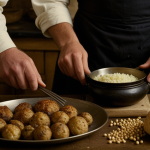Strategies for Evolving British Cuisine While Honouring Tradition
Maintaining culinary tradition while embracing British cuisine evolution requires a delicate balance. One effective strategy is adopting global flavors and techniques within the framework of classic British recipes. This allows chefs to innovate without losing the essence of time-honoured dishes. For example, incorporating spices or cooking methods from other cultures can enrich familiar meals, adding depth and excitement while respecting their origins.
At the same time, preserving core ingredients and traditional cooking methods remains crucial. Staples like suet, root vegetables, and slow roasting continue to define British food. By retaining these elements, cooks ensure that the dishes’ identity remains intact even as new flavors emerge.
Topic to read : What Are the Unique Historical Influences on Traditional British Cooking?
The challenge lies in balancing change with respect for historical meals. Chefs and home cooks alike can update presentations or add contemporary twists, but they must safeguard the soul of the dish. This strategy promotes a vibrant culinary future, where modern British food evolves thoughtfully, honouring its rich heritage while inviting innovation.
Practical Innovations in British Cooking
British food innovation increasingly relies on the smart use of modern ingredients while retaining the soul of traditional dishes. One key strategy is incorporating sustainable and locally-sourced ingredients into familiar recipes, supporting both environmental goals and regional agriculture. For instance, many chefs substitute intensively farmed products with artisanal, seasonal options, enhancing freshness and flavor without sacrificing authenticity.
Also read : What are the must-try regional UK foods?
Another significant development is the integration of plant-based or health-conscious alternatives. Classic British plates, often seen as hearty and meat-centric, are being reimagined with vegetables, legumes, or meat substitutes, maintaining comforting textures and tastes but aligning with evolving dietary preferences. This approach exemplifies how food innovation can refresh tradition while appealing to contemporary diners.
Chef-led reinterpretations further showcase this balance. Successful restaurants excel by offering plates where heritage meets creativity—using techniques like slow cooking alongside sous vide or fermenting. They provide an example of how modern British food can honor culinary roots yet embrace new methods for enhanced taste and presentation.
Strategies for Evolving British Cuisine While Honouring Tradition
Balancing British cuisine evolution with culinary tradition involves thoughtful adaptation. One effective approach is adopting global flavors and techniques within classic British recipes. For example, introducing spices from Indian or Middle Eastern cuisines can complement traditional ingredients like root vegetables, creating dishes that are both familiar and exciting. Chefs employing these methods show how modern British food can be enriched without losing its identity.
Maintaining core ingredients remains vital. Slow roasting and staple components such as suet or marrow preserve the authenticity that defines British fare. This anchors innovation in heritage, preventing radical departures that might alienate traditionalists.
The key challenge is balancing change with respect for historical meals. A sensitive evolution means incorporating new elements while honoring the dish’s essence. This ensures food innovation enhances rather than replaces the culinary legacy, supporting a dynamic yet respectful progression in British cooking.
Strategies for Evolving British Cuisine While Honouring Tradition
Adopting global flavors into classic British recipes is a cornerstone of successful British cuisine evolution. Introducing spices like cardamom or cumin enriches traditional dishes featuring root vegetables or meats, blending familiarity with excitement. This thoughtful integration allows modern British food to evolve while maintaining its distinct character.
Equally vital is maintaining core ingredients and traditional cooking methods. Staples such as suet, marrow, and slow roasting techniques preserve the authentic taste and texture that define British fare. These elements act as anchors, ensuring the culinary tradition remains central despite new influences.
Balancing change with respect for historical meals requires careful judgment. Innovation should enhance the dish’s soul, not overshadow it. For example, new presentation styles or subtle flavor additions can update classics without eroding their heritage. This sensitive approach to food innovation creates dishes that honor the past while inviting creative progress.
Strategies for Evolving British Cuisine While Honouring Tradition
Evolving British cuisine while respecting culinary tradition requires a mindful blend of innovation and preservation. One effective strategy is incorporating global flavors and techniques, such as spices from Middle Eastern or Asian cuisines, into classic recipes. This approach expands the palate of modern British food without diluting its core identity.
Crucially, maintaining traditional methods remains central. Slow roasting, use of signature ingredients like suet and marrow, and time-honoured preparation techniques ensure the essence stays intact. These elements anchor British cuisine evolution by connecting new creations to their historic roots.
Balancing change with respect involves subtlety: enhancements should complement rather than overpower the dish’s original character. For example, a classic stew might incorporate a hint of exotic spice but still rely on familiar textures and flavors. This thoughtful interplay of preservation and innovation deepens appreciation for both the heritage and future direction of British food.
Through such strategies, food innovation becomes a bridge, linking tradition with contemporary tastes and fostering a dynamic yet respectful culinary evolution.






